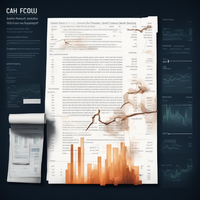Bank Financial Statements

Bank financial statements provide a comprehensive overview of a bank's financial performance and position. These statements are prepared in accordance with accounting principles and regulatory requirements to ensure transparency and accountability in the banking industry.
There are three main types of bank financial statements:
Balance Sheet: This statement represents the bank's assets, liabilities, and shareholders' equity at a specific point in time. The balance sheet follows the equation: Assets = Liabilities + Shareholders' Equity. It provides information on the bank's liquidity, solvency, and capital structure.
Assets: The assets section includes cash, loans, investments, property, plant & equipment (if any), and other assets owned by the bank.
Liabilities: The liabilities section comprises deposits from customers, borrowings from other banks or financial institutions, issued debt securities (bonds), accrued expenses, and other debts owed by the bank.
Shareholders' Equity: Shareholders' equity represents the net worth of the bank calculated as Total Assets minus Total Liabilities. It includes common stock, retained earnings (profits reinvested into the business), additional paid-in capital (from issuing new shares at a premium), and other equity components.
Income Statement: Also known as profit & loss statement or statement of earnings/profitability; this statement shows a summary of revenue generated against various expense categories over a specific period (usually one year). It outlines whether the bank has made profits or incurred losses during that period.
Revenue: The income statement highlights revenues earned by banks through interest income on loans/credit facilities provided to customers; fees/commissions charged for services offered such as credit cards processing fees or advisory services fees; gains realized from selling investments/securities/bonds; etc.
Expenses: Banks incur various expenses such as personnel salaries/wages/bonuses/incentives; rent/lease expenses for branch offices; IT infrastructure & maintenance expenses; marketing/advertising costs; provision for loan losses (to cover potential default by borrowers); regulatory compliance costs, and other operating expenses.
Cash Flow Statement: This statement tracks the cash inflows and outflows of a bank during a specific period. It provides insights into how the bank generates and uses its cash resources from operational activities, investing activities, and financing activities.
Operating Activities: Cash flows generated/used through banking transactions (e.g., interest received/paid on loans/deposits), fees/commissions earned or paid to third parties, taxes paid/received, etc.
Investing Activities: Cash flows related to buying/selling investments like securities/bonds/shares issued by other companies (not customers' deposits).
Financing Activities: Cash flows resulting from raising funds such as issuing new shares or bonds (to increase capital), borrowing funds from other banks/institutions or repaying existing debts/facilitating dividends distribution to shareholders.
These financial statements are integral tools used by various stakeholders to assess a bank's financial health. They help regulators monitor compliance with capital adequacy requirements while enabling investors, analysts, rating agencies, and customers to evaluate the bank's profitability, liquidity position, solvency ratios, risk exposure levels/types of assets held liabilities incurred) amongst others.
Sponsored
Sponsored
Sponsored
Explore More:

Operational Risk
Operational risk is the potential for loss resulting from inadequate or failed internal...

Market Risk
Risk management in banking is a critical aspect of the banking industry. Managing...

Credit Risk
Risk management in banking is a critical aspect of the banking industry. Managing...

Risk Management in Banking
Risk management in banking is a critical aspect of the banking industry. Managing...

Glass-Steagall Act
The Glass-Steagall Act, also known as the Banking Act of 1933, was an...

Dodd-Frank Act
The Dodd-Frank Act, officially known as the Dodd-Frank Wall Street Reform and Consumer...

Basel Accords
Banking regulations refer to the laws, rules, and guidelines imposed by regulatory authorities...

Banking Regulations
Banking regulations refer to the laws, rules, and guidelines imposed by regulatory authorities...

Cash Flow Statement
The cash flow statement is an important financial statement for banks as it...

Income Statement
The income statement is an essential component of a bank's financial statements. It...

Balance Sheet
The balance sheet is one of the most important financial statements used by...

Online and Mobile Banking
In today's rapidly evolving technology landscape, the banking industry has undergone a significant...

Credit Cards
Credit cards are one of the most prominent banking products offered by financial...

Understanding Different Types of Bank Loans: Features and Benefits for Personal and Business Financing
Loans are a core offering of banking institutions, providing individuals and businesses with...

Checking Accounts
A checking account is one of the most common banking products used by...

Saving Accounts
Introduction In the world of banking, saving accounts are one of the most...